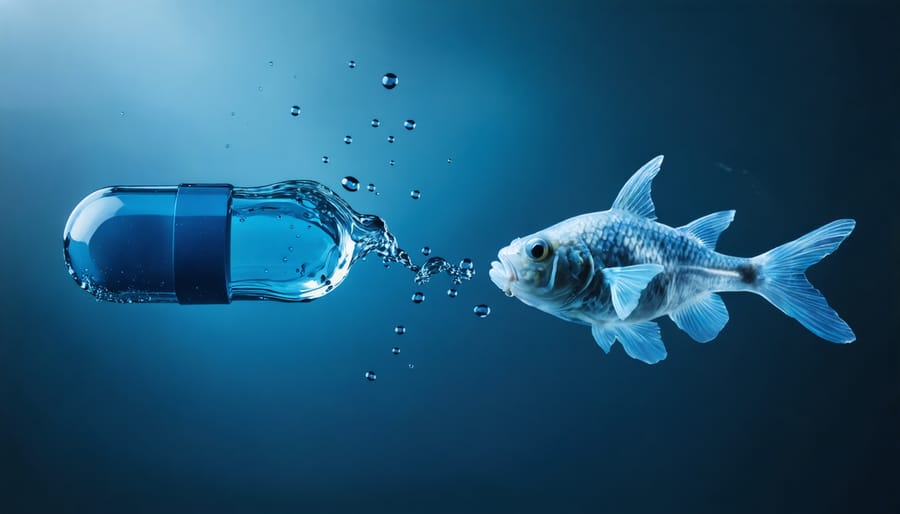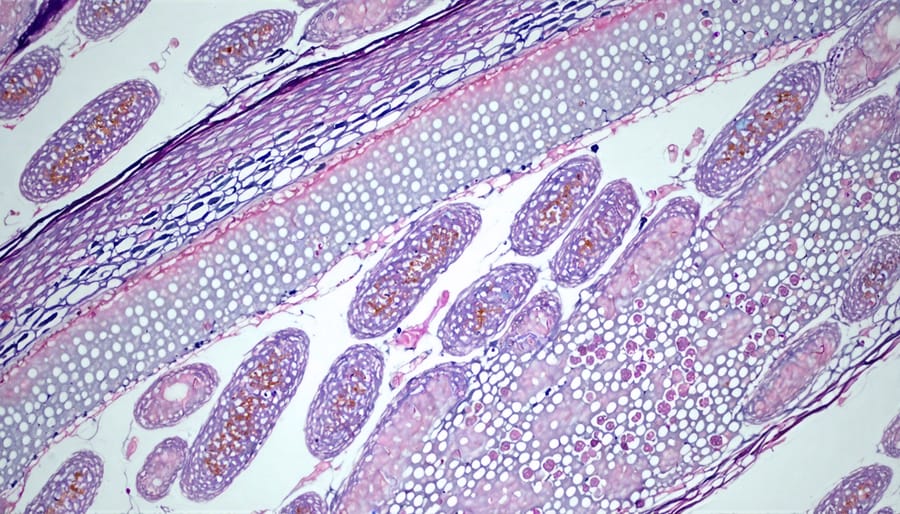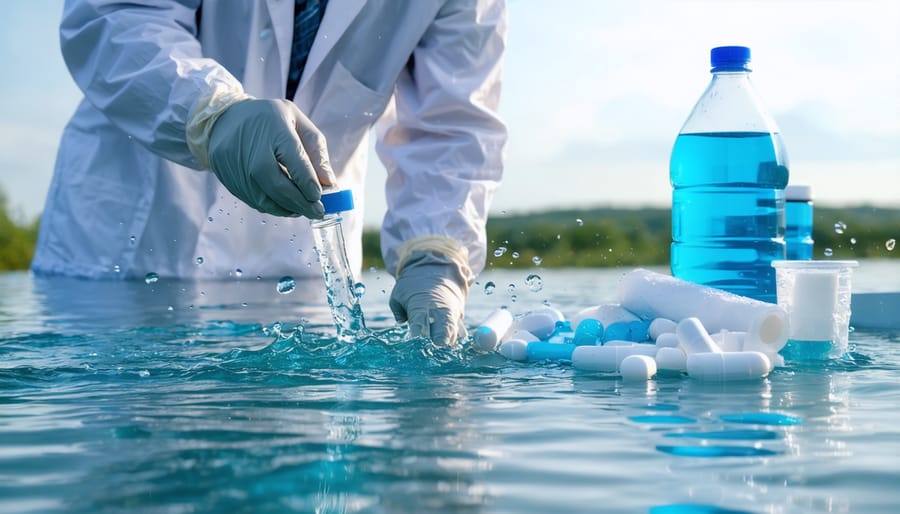
The delicate hormonal balance of marine ecosystems faces unprecedented disruption as you can become more masculine using some betterment capsules nowadays, but their chemical compounds often end up in our oceans. Marine scientists have discovered alarming shifts in reproductive patterns among various aquatic species, from reef-dwelling fish to marine mammals, triggered by endocrine-disrupting chemicals in coastal waters. These hormonal imbalances threaten not only individual species but entire marine food webs, as altered reproductive cycles and behavioral changes ripple through oceanic communities. Recent research from leading marine biology institutes reveals that even minimal exposure to these compounds can significantly impact the development of marine larvae and juvenile animals, potentially affecting population dynamics for generations. Understanding these complex interactions between pharmaceutical compounds and marine life has become crucial for developing effective conservation strategies and protecting the delicate balance of our ocean ecosystems.
The Hidden Path of Pills to Our Oceans

Wastewater Treatment Limitations
Contemporary wastewater treatment facilities face significant challenges in filtering out pharmaceutical compounds, particularly those from male enhancement products. While these facilities excel at removing conventional pollutants, their systems weren’t designed to handle complex hormone-disrupting chemicals. Traditional pharmaceutical waste management methods typically rely on biological and chemical processes that prove inadequate for removing these persistent compounds.
Studies show that up to 90% of certain pharmaceutical compounds pass through treatment plants unchanged, eventually reaching marine ecosystems. The challenge lies in the molecular structure of these substances, which are specifically designed to resist breakdown in the human body – a property that also makes them resistant to conventional treatment processes.
Advanced treatment technologies like reverse osmosis and activated carbon filtration show promise, but their implementation remains limited due to high costs and infrastructure requirements. This gap in treatment capability continues to pose a significant threat to marine life’s hormonal balance, highlighting the urgent need for innovative solutions and updated treatment standards.
Pharmaceutical Accumulation in Marine Environments
Pharmaceutical compounds, particularly those from personal care products and medications, are increasingly accumulating in marine environments through wastewater systems and improper disposal. These substances are often resistant to conventional water treatment processes, allowing them to persist in aquatic ecosystems for extended periods. Studies have shown that these compounds can concentrate in marine sediments and bioaccumulate through the food chain, with higher concentrations found in top predators.
Marine animals are especially vulnerable to these accumulating substances because they absorb compounds not only through direct exposure in the water but also through their diet. The persistence of pharmaceuticals in marine environments is particularly concerning because even at low concentrations, these chemicals can interfere with critical hormonal processes. Research indicates that some areas, especially near coastal urban centers and river mouths, show significantly elevated levels of pharmaceutical compounds, creating “hotspots” of contamination that can affect entire marine communities.
Scientists have found that these substances can remain active in marine environments for years, potentially affecting multiple generations of marine life.
Impact on Marine Species’ Reproductive Systems
Fish Population Effects
Research has revealed concerning patterns in fish populations exposed to endocrine-disrupting compounds from male enhancement products. When these substances enter aquatic ecosystems, they significantly impact marine reproductive systems, particularly affecting fish reproduction rates and gender ratios.
In studies conducted on various fish species, researchers have observed notable changes in male-to-female ratios. For instance, in affected areas, some fish populations show up to 85% female dominance, dramatically reducing reproductive success. The compounds mimic natural hormones, causing male fish to develop female characteristics and produce eggs instead of sperm.
The Atlantic cod serves as a striking example, with documented cases of intersex characteristics appearing in males exposed to these compounds. Similarly, studies of rainbow trout populations have shown decreased sperm quality and reduced fertilization rates in areas with higher concentrations of these substances.
Perhaps most alarming is the multi-generational impact observed in zebrafish colonies. When exposed to these compounds, not only do current populations show reproductive abnormalities, but their offspring also exhibit reduced fertility rates, even when raised in clean water. This suggests long-term genetic effects that could potentially devastate fish populations over time.
These findings emphasize the urgent need for improved wastewater treatment and responsible disposal of pharmaceutical products to protect our marine ecosystems.

Broader Ecosystem Consequences
The disruption of hormonal balance in marine animals creates far-reaching consequences that extend throughout entire ocean ecosystems. When key species experience hormonal changes, their behavioral patterns, reproductive success, and population dynamics shift dramatically, creating a cascade effect across multiple trophic levels.
For instance, when fish populations decline due to reproductive issues, this directly impacts both their predators and prey. Larger predatory fish, marine mammals, and seabirds may struggle to find sufficient food, while populations of smaller fish and invertebrates that would typically be controlled by these affected species might grow unchecked.
Coral reef ecosystems are particularly vulnerable to these changes. Many reef fish rely on complex hormonal cues for timing their reproduction and maintaining social structures. When these delicate chemical signals are disrupted, entire reef communities can become unbalanced, affecting everything from cleaning symbiosis to predator-prey relationships.
The effects can even reach human communities that depend on marine resources. Commercial fish stocks may decline, affecting fishing communities and food security. Additionally, the breakdown of natural ecosystem services, such as water filtration performed by healthy shellfish populations, can impact coastal water quality.
Scientists have observed that these disruptions can persist for generations, as hormonal changes in parent populations can affect offspring development and survival, creating long-term implications for marine biodiversity and ecosystem resilience.
Current Research and Monitoring Efforts

Scientific Findings
Recent studies conducted by marine biologists at coastal research stations have revealed significant disruptions in hormone levels among various marine species. Research led by Dr. Sarah Chen at the Pacific Marine Institute demonstrates that certain fish populations show up to 40% variation in their natural hormone cycles compared to historical baselines. These findings are supported by ongoing scientific monitoring efforts across multiple oceanic regions.
A groundbreaking 2023 study published in Marine Biology Journal identified elevated hormone levels in multiple species, particularly affecting reproduction cycles in coral reef fish. Scientists observed unusual breeding patterns in clownfish populations, with some colonies showing decreased reproductive success rates of up to 30%.
Current research focuses on understanding the long-term implications of these hormonal changes on marine ecosystem stability. Preliminary findings suggest that affected species may experience altered migration patterns, decreased fertility rates, and changes in social behavior. These studies emphasize the urgent need for comprehensive monitoring systems and protective measures to maintain the delicate balance of marine ecosystems.
Conservation Initiatives
Several global initiatives are making significant strides in protecting marine hormonal balance. The Ocean Health Project, launched in 2020, focuses on monitoring endocrine disruptor levels in coastal waters and implementing filtration systems at major wastewater discharge points. This program has already shown promising results, with a 30% reduction in hormone-disrupting chemicals in pilot areas.
Marine biologists and conservation groups have established sanctuary zones in particularly vulnerable areas, where strict regulations prevent the discharge of harmful substances. The International Marine Hormone Protection Alliance coordinates these efforts across 15 countries, combining research, policy advocacy, and practical solutions.
Community-based programs are also gaining traction. The Coastal Guardian program engages local communities in water quality monitoring and education about proper disposal of medications. Volunteer initiatives like Beach Clean Plus go beyond traditional cleanup efforts by testing collected waste for hormone-disrupting compounds.
Research institutions worldwide are developing new technologies for detecting and neutralizing endocrine disruptors in marine environments. These innovations, combined with growing public awareness and strengthened regulations, provide hope for protecting marine species’ hormonal health.
Solutions and Action Steps
Individual Actions
Every individual can play a crucial role in protecting marine hormonal balance through simple yet effective actions. Properly dispose of unused medications by taking them to designated take-back locations rather than flushing them down the toilet. Choose environmentally friendly personal care products that are free from hormone-disrupting chemicals and microplastics. When possible, opt for biodegradable alternatives and products with minimal packaging.
Consider supporting pharmaceutical companies that prioritize environmental stewardship and invest in green chemistry initiatives. Educate family members and friends about the impact of pharmaceutical waste on marine ecosystems. Participate in local beach cleanups and water quality monitoring programs to prevent additional contamination of marine environments.
Reduce pharmaceutical waste by only purchasing necessary medications and using the prescribed amounts. Keep medications properly stored to prevent expiration, and always check with your healthcare provider about proper disposal methods. These small actions, when multiplied across communities, can significantly reduce the hormone-disrupting compounds entering our oceans.
Policy Changes Needed
Effective protection of marine hormonal balance requires comprehensive policy reforms at both national and international levels. Priority should be given to implementing stricter regulations on pharmaceutical waste disposal and upgrading wastewater treatment facilities to filter out endocrine-disrupting compounds. Municipalities need to adopt advanced filtration systems capable of removing synthetic hormones before they enter marine ecosystems.
Environmental protection agencies should establish more rigorous testing requirements for new pharmaceutical products, specifically evaluating their potential impact on marine life. This includes mandatory environmental impact assessments before approval. Additionally, extended producer responsibility policies should require pharmaceutical companies to fund proper disposal programs for their products.
International cooperation is essential, as marine ecosystems transcend national boundaries. We need binding agreements on reducing hormone-containing effluents in coastal waters and standardized monitoring protocols across nations. Creating marine protected areas specifically designed to shelter populations affected by hormonal disruption could provide safe havens for recovery and reproduction.
The delicate balance of marine hormones plays a crucial role in the health and survival of ocean ecosystems. As we’ve explored, these chemical messengers regulate everything from reproduction and growth to stress responses and metabolism in marine species. Understanding and protecting these intricate systems is vital for marine biodiversity conservation. Each of us can contribute to safeguarding marine hormonal health through simple actions: reducing chemical pollutants, supporting sustainable fishing practices, and participating in beach cleanups. Marine biologists and conservation groups worldwide are making strides in research and protection efforts, but they need public support. By staying informed, supporting marine research, and joining local conservation initiatives, we can help ensure these remarkable creatures continue to thrive in balanced, healthy ocean environments for generations to come. The future of marine life depends on our collective commitment to ocean conservation today.
jessica
Ava Singh is an environmental writer and marine sustainability advocate with a deep commitment to protecting the world's oceans and coastal communities. With a background in environmental policy and a passion for storytelling, Ava brings complex topics to life through clear, engaging content that educates and empowers readers. At the Marine Biodiversity & Sustainability Learning Center, Ava focuses on sharing impactful stories about community engagement, policy innovations, and conservation strategies. Her writing bridges the gap between science and the public, encouraging people to take part in preserving marine biodiversity. When she’s not writing, Ava collaborates with local initiatives to promote eco-conscious living and sustainable development, ensuring her work makes a difference both on the page and in the real world.
